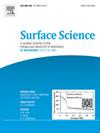Effect of biaxial tensile strain on the photovoltaic properties of O-doped monolayer SnSe2: a first-principles study
IF 1.8
4区 化学
Q3 CHEMISTRY, PHYSICAL
引用次数: 0
Abstract
In this study, we investigate the synergistic modulation mechanism of non-metallic element O doping and biaxial tensile strain on the electronic structure and optical properties of monolayer SnSe2 materials based on DFT. In particular, oxygen doping can transform SnSe2 from an indirect bandgap to a direct bandgap, thus improving its photoelectric conversion efficiency. After applying biaxial tensile strains (2 %-8 %), the bandgap of the O-doped system shows a nonlinear change, which increases to 0.458 eV at 4 % strain and maintains semiconducting properties. In terms of optical properties, O- doped with strain regime significantly improves static dielectric constant (up to 4.03 at 8 % strain) and the light absorption efficiency, and the reflectance in the UV region decrease to 0.13, indicating a significant enhancement of the photovoltaic conversion performance. It has been shown that the 2D Materials semiconductor SnSe2 can significantly improve the carrier mobility and light absorption efficiency of the material in the doping and stretching regime, which lays the foundation for the development of high-efficiency optoelectronic devices.
双轴拉伸应变对o掺杂单层SnSe2光电性能影响的第一性原理研究
在这项研究中,我们研究了非金属元素O掺杂和双轴拉伸应变对基于DFT的单层SnSe2材料的电子结构和光学性质的协同调制机制。特别是,氧掺杂可以将SnSe2从间接带隙转变为直接带隙,从而提高其光电转换效率。在施加双轴拉伸应变(2% ~ 8%)后,掺o体系的带隙呈现非线性变化,在4%应变下增加到0.458 eV,并保持半导体性能。光学性能方面,应变掺O显著提高了材料的静态介电常数(8%应变下可达4.03)和光吸收效率,紫外区反射率降至0.13,光伏转换性能显著增强。研究表明,在掺杂和拉伸状态下,2D Materials半导体SnSe2可以显著提高材料的载流子迁移率和光吸收效率,这为开发高效光电器件奠定了基础。
本文章由计算机程序翻译,如有差异,请以英文原文为准。
求助全文
约1分钟内获得全文
求助全文
来源期刊

Surface Science
化学-物理:凝聚态物理
CiteScore
3.30
自引率
5.30%
发文量
137
审稿时长
25 days
期刊介绍:
Surface Science is devoted to elucidating the fundamental aspects of chemistry and physics occurring at a wide range of surfaces and interfaces and to disseminating this knowledge fast. The journal welcomes a broad spectrum of topics, including but not limited to:
• model systems (e.g. in Ultra High Vacuum) under well-controlled reactive conditions
• nanoscale science and engineering, including manipulation of matter at the atomic/molecular scale and assembly phenomena
• reactivity of surfaces as related to various applied areas including heterogeneous catalysis, chemistry at electrified interfaces, and semiconductors functionalization
• phenomena at interfaces relevant to energy storage and conversion, and fuels production and utilization
• surface reactivity for environmental protection and pollution remediation
• interactions at surfaces of soft matter, including polymers and biomaterials.
Both experimental and theoretical work, including modeling, is within the scope of the journal. Work published in Surface Science reaches a wide readership, from chemistry and physics to biology and materials science and engineering, providing an excellent forum for cross-fertilization of ideas and broad dissemination of scientific discoveries.
 求助内容:
求助内容: 应助结果提醒方式:
应助结果提醒方式:


